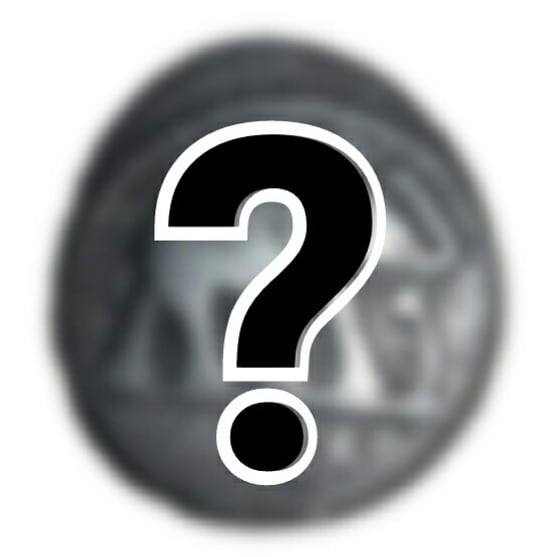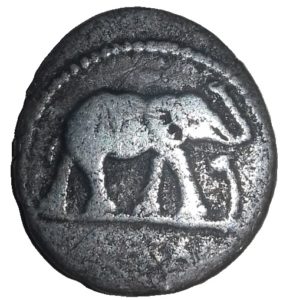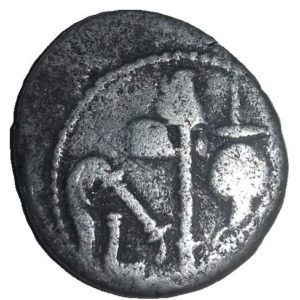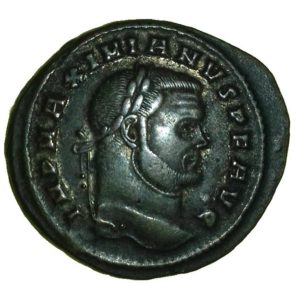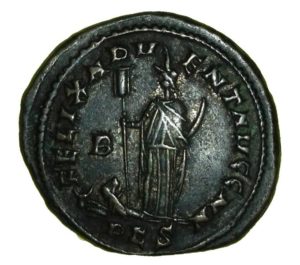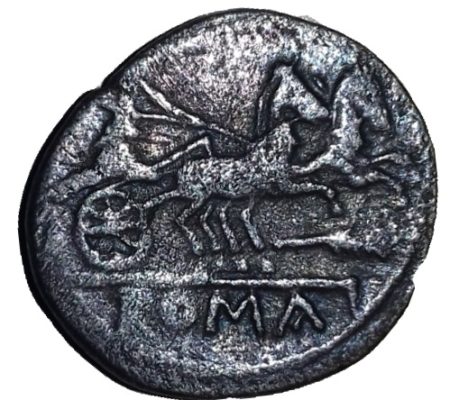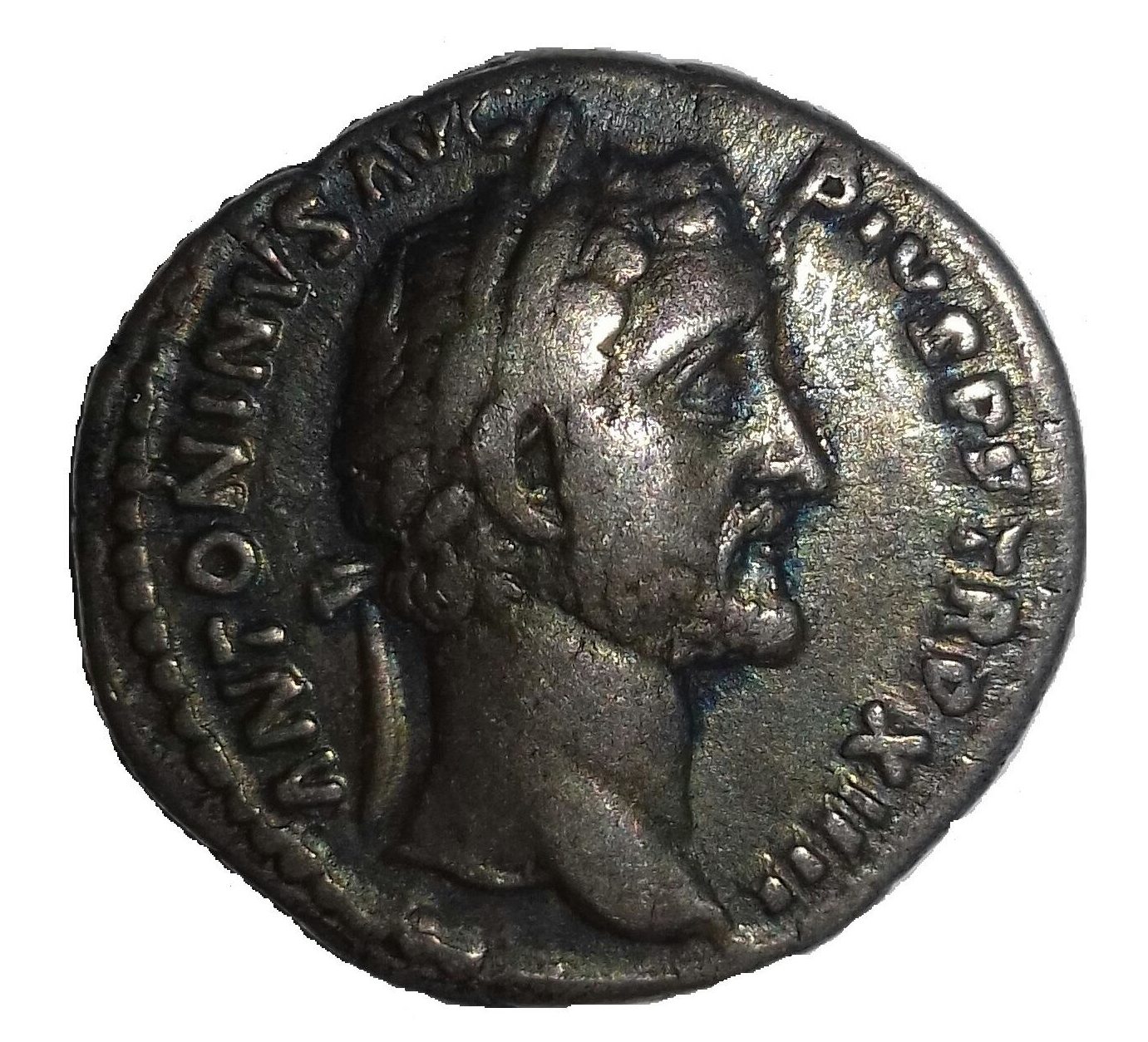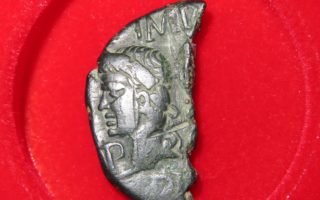The most important thing in numismatics is the identification of coins. To identify a Roman coin, there are several steps:
– determine the type (sestertius, denarius, nummus, …)
– determine the averse (emperor, empress, …)
– determine the setback (allegory, animal, …)
1) Determine the type of coin
To determine the type of coin, first identify the metal that
constitutes it. For this, a simple look is enough. If the coin is greenish/coppery, it is a copper or bronze coin. The green color is caused by the oxidation of the metal or by the patina of the coin.
Then, if the coin is silver or slightly grey, it is silver or billon. Finally, if the coin is golden, you are a lucky person because it will be a gold coin
Once the metal has been determined, measure the diameter of the coin. For example, for a silver coin of 18mm, it will be a denarius. Once the diameter is determined, weigh your coin to find out its weight.
Here is a table from my book The Roman Coins in just 20 pages.
(The weights that will follow are imprecise because they have varied during the Ancient Rome and over the centuries the coins have lost their weight).
| The type | The composition | Diameter (mm) | Weight (gram) |
| Aureus | Gold | 18/19 | 7/8 |
| Gold Quinar | Gold | 17 | 3.9 |
| Denar | Silver | 18/19 | 3/4 |
| Cistophorus | Silver | 25 | 10/11 |
| Quinar | Silver | 14/17 | 1.5/2 |
| Semis / Quadrans | Copper | 15/16 | 2/3 |
| As | Copper | 26 | 12 |
| Dupondius | Copper | 20/30 | 11/15 |
| Sestertius | Copper | 28/36 | 15/25 |
| Antoninianus | Billon | 20/23 | 2/4 |
| Aurélianus | Billon | 21/22 | 4 |
| Nummus | Copper | 17/20 | 2/3.5 |
| Follis | Copper | 24/28 | 6/10 |
| Siliqua | Silver | 16/19 | 1.5/2 |
| Argenteus | Silver | 19/20 | 3/3.5 |
| Miliarense | Silver | 21/23 | 3.8/4.5 |
| Solidus | Gold | 20/21 | 4/4.5 |
| Semis/Semissis | Gold | 18 | 2.25 |
| Tremissis | Gold | 14 | 1.5 |
After determining the type of your coin, you must determine the character on the forehead of the coin.
2) Determine the averse of the coin
This step is a problem if the averse has no character. Indeed, some coins have animals or allegories (representation of an idea such as freedom, fortune …) instead of emperor or empress, but this possibility is rather rare. If this happens to you and you have, for example, a denarius with an elephant on the setback, you just have to write “elephant denarius” on the internet and looking in the various images, you will have no trouble identifying your coin. I advise you to use the internet because in these cases, the name of the person who issued the coin is usually not indicated, and it is therefore difficult to search in a book because the characters are usually arranged in alphabetical order.
So, you know how to determine a coin when no character appear.
Now, here’s how to determine the character present on the averse of coin.
To determine the character on the coin, there are several possibilities:
- Read the legend
- Recognize the Emperor or Empress
- Read the caption
Reading the legend is the safest way to determine which emperor it is, because like many emperors were similar, it is difficult when you are a beginner to differentiate them. So, the risk of error is sometimes important. Reading the legend is very easy. Indeed, most of the time the name of the emperor is written in full letter and at the end of the name a Latin-sounding ending. For example, for Antonin the Pious, it will be written “Antoninus Pius”.
- Recognize the Emperor or Empress
Recognizing the emperor or empress visually is a good way but I advise against beginners because as I said previously, many emperors were very similar. With many experience, you can determine easily which emperor it is at first glance but w hen you are a beginner, the simplest way is to take a list of all the portraits of emperors and empresses and compare them to the point of getting a perfect resemblance. I recommend the list of portraits in the book Die Munzen der romischen Kaiserzeit, (see page “My Material” on my website).
3. Determine the setback
To determine the setback, there still several possibilities depending on what appears on this latter. There can be : animals, objects, allegories …
If there are animals, just recognize which animal it is and that’s all, the identification is complete.
For example, if you have found as a type of coins, an “Antoninian”, that the emperor on the coin is according to you “Gallianus” and that on the setback you recognize a “pegasus”, your coin is an “Antoninian of Gallian at the Pegasus”.
The same if it is an object like instruments, galleys (Roman ships)…
If it’s an allegory, you can resume the steps identification of the averse because here too you can read the legend. By for example, the “Fortune” becomes “Fortuna.” If not, you can determine what allegory it is by yourself. If you are a beginner, I don’t recommend you this method once again, although here it is easier than for emperors. However, if you want to practice recognizing them, I advise you once again on the book Die Munzen der romischen Kaiserzeit which contains a list of all the different allegories. In addition, you have the list of portraits and the list of allegories in a single book.
Last case, the legend does not correspond with the allegory. For example, the allegory is “Fortuna” but the caption is “COS IIII” Here you have two solutions. In fact, either you determine the allegory visually or with the help of a book, or you look for a coin with the same legend in a book or on the internet and normally, in the description of the coin, the name of the coin. corresponding allegory will be specified.
Here’s how to identify a Roman coin. Now, if you have unidentified coins near you, try the methods. One more thing, here is a Roman coin that I will let you identify. Mark in the comments if you were able to determine its type, the emperor and his reverse.
Weight: 10 g Diameter: 28 mm
This article is now finished. Now practice and try to be able to identify any coin at first glance. In addition, you can now determine the price of coins. By the way, I wrote an article about it. If you want more, click here to receive the entire book (remember, it’s free, so don’t hesitate). Also, tell me what subject related to Roman coins you would like me to talk about. As for next week’s article, it will be “The Metal Detecting” See you next week !
Don’t forget to visit my shop
Receive my free book Around the Roman Coin by clicking here

